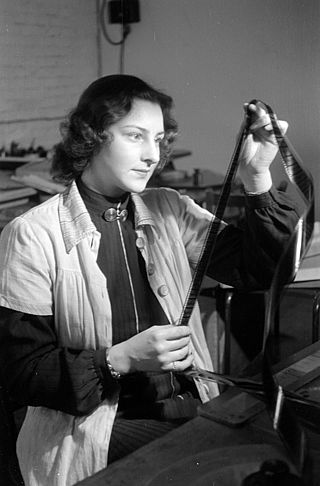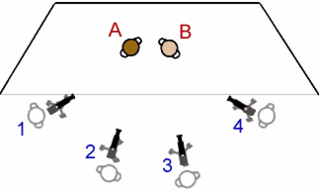Related Research Articles

Film editing is both a creative and a technical part of the post-production process of filmmaking. The term is derived from the traditional process of working with film which increasingly involves the use of digital technology.

Post-production is part of the process of filmmaking, video production, audio production, and photography. Post-production includes all stages of production occurring after principal photography or recording individual program segments.

A compression artifact is a noticeable distortion of media caused by the application of lossy compression. Lossy data compression involves discarding some of the media's data so that it becomes small enough to be stored within the desired disk space or transmitted (streamed) within the available bandwidth. If the compressor cannot store enough data in the compressed version, the result is a loss of quality, or introduction of artifacts. The compression algorithm may not be intelligent enough to discriminate between distortions of little subjective importance and those objectionable to the user.

iMovie is a free video editing application made by Apple for the Mac, the iPhone, and the iPad. It includes a range of video effects and tools like color correction and image stabilization, but is designed to be accessible to users with little or no video editing experience. iMovie's professional equivalent is Apple's Final Cut Pro X.

Final Cut Pro is a professional non-linear video-editing application initially developed by Macromedia, and, since 1998, by Apple as part of its pro apps collection. Final Cut Pro allows users to import, edit, and process video footage, and output it to a wide variety of formats.

A film transition is a technique used in the post-production process of film editing and video editing by which scenes or shots are combined. Most commonly this is through a normal cut to the next shot. Most films will also include selective use of other transitions, usually to convey a tone or mood, suggest the passage of time, or separate parts of the story. These other transitions may include dissolves, L cuts, fades, match cuts, and wipes.
Sound design is the art and practice of creating soundtracks for a variety of needs. It involves specifying, acquiring or creating auditory elements using audio production techniques and tools. It is employed in a variety of disciplines including filmmaking, television production, video game development, theatre, sound recording and reproduction, live performance, sound art, post-production, radio, new media and musical instrument development. Sound design commonly involves performing and editing of previously composed or recorded audio, such as sound effects and dialogue for the purposes of the medium, but it can also involve creating sounds from scratch through synthesizers. A sound designer is one who practices sound design.

Vegas Pro is a video editing software package for non-linear editing (NLE). The first release of Vegas Beta was on June 11, 1999. The software runs on Windows operating systems.
Offline editing is part of the post-production process of film making and television production in which raw footage is copied and the copy only is then edited, thereby not affecting the camera original film stock or video tape. Once the project has been completely offline edited, the original media will be assembled in the online editing stage.
This article contains a list of cinematic techniques that are divided into categories and briefly described.
A re-edited film is a motion picture that has been modified from the manner in which it was showcased in its original theatrical release. Reasons for this type of editing may range from the distributor's demands to accommodating different audience groups. Fan-made movie edits are often met with controversy, as they bring up issues of copyright law.
Montage is a film editing technique in which a series of short shots are sequenced to condense space, time, and information.
In filmmaking, the rough cut is the second of three stages of offline editing. The term originates from the early days of filmmaking when film stock was physically cut and reassembled, but is still used to describe projects that are recorded and edited digitally.

The multiple-camera setup, multiple-camera mode of production, multi-camera or simply multicam is a method of filmmaking and video production. Several cameras—either film or professional video cameras—are employed on the set and simultaneously record or broadcast a scene. It is often contrasted with a single-camera setup, which uses one camera.

A film – also called a movie, motion picture, moving picture, picture, photoplay or (slang) flick – is a work of visual art that simulates experiences and otherwise communicates ideas, stories, perceptions, feelings, beauty, or atmosphere through the use of moving images. These images are generally accompanied by sound and, more rarely, other sensory stimulations. The word "cinema", short for cinematography, is often used to refer to filmmaking and the film industry, and to the art form that is the result of it.
The St. Louis Film Critics Association (SLFCA) is an organization of film critics operating in Greater St. Louis and adjoining areas of Missouri and Illinois which was founded in 2004.
A split edit, is a transition from one shot to another in film or video, where transition of the audio and video happen at different times. This is often done to enhance the aesthetics or flow of the film, allowing the audience to see context—either before or after—of speaking rather than simply the speaking itself. Without split edit, a conversation between two people can feel like a tennis match.
A J cut is a variant of a split edit film editing technique in which the audio from a following scene overlaps the picture from the preceding scene, so that the audio portion of the later scene starts playing before its picture as a lead-in to the visual cut. Also called an audio lead or audio advance.
This glossary of motion picture terms is a list of definitions of terms and concepts related to motion pictures, filmmaking, cinematography, and the film industry in general.

DaVinci Resolve is a color grading, color correction, visual effects, and audio post-production video editing application for macOS, Windows, and Linux, developed by Blackmagic Design. It was originally developed by da Vinci Systems as da Vinci Resolve until 2009, when da Vinci Systems was acquired by Blackmagic Design. In addition to the commercial version of the software, Blackmagic Design also distributes a free edition, with reduced functionality, simply named DaVinci Resolve.
References
- ↑ "Final Cut Pro X: Create split edits". Calgary Board of Education. Retrieved 5 December 2016.
- ↑ "Digital Video Editing Terminology" . Retrieved 5 December 2016.
- ↑ Paul, Johnathan (8 March 2016). "Video Editing: What Are J-Cuts and L-Cuts?". The Beat: A Blog by PremiumBeat. Retrieved 25 August 2020.